Message from the CEO
With the goal of becoming a digital company with insight into implicit challenges, Konica Minolta will transform itself into a high-profit company capable of sustainable growth.
Shoei Yamana
President and CEO
With the goal of becoming a digital company with insight into implicit challenges, Konica Minolta will transform itself into a high-profit company capable of sustainable growth.
Shoei Yamana
President and CEO
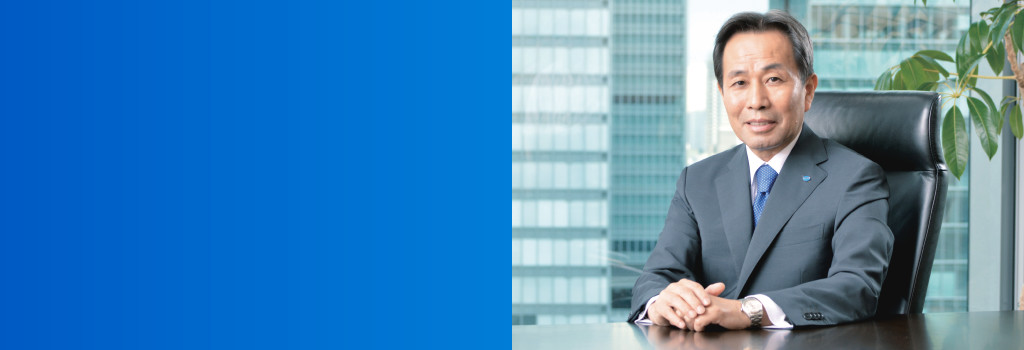
The so-called IT revolution has sparked dramatic social change in recent years, from macro-level change involving business models and industrial structures to change on a more personal level with lifestyles and the way people work being affected. Now, the Internet of Things (IoT)—the connection of all things via the Internet—has led to the continuous creation of unprecedented value and businesses in a broad range of domains. Even prior to being appointed president, I was determined to change the way Konica Minolta competes given that we are entering the age of IoT and transform us into a game changer.
Konica Minolta’s strengths can be divided into two broad categories. The first consists of the "core technologies" we have developed over our long history. These are the imaging, material, nanofabrication, and optical technologies that we have nurtured since the early phase of our existence, when we made cameras and film. Konica Minolta is a manufacturing company that has delivered world’s “firsts” and “bests,” including the world's most sensitive film, the world's first autofocus cameras, and the world's first copiers equipped with a zoom function. Achievement and innovation are in our DNA.
Our other strength is the bond we have forged with about two million corporate clients from 150 countries around the world nurtured through the sales of and services for such products as digital MFPs, medical image diagnostic equipment, and measuring instruments. And though our clients span a broad range of industries—manufacturing, distribution and retailing, printing, and healthcare and nursing, to name a few—more and more are demanding IT-based workflow solutions that lead to increased productivity, improved marketing ROI, and innovations to their business models.
With this in mind, we have worked steadily to achieve the objectives outlined in the TRANSFORM 2016 Medium Term Business Plan since 2014 toward providing enhanced value to customers. Over the three-year period of the plan, we have invested more than \120 billion and promoted a variety of preparatory steps devised to lead us down the path to sustainable growth.
One preparatory step of particular importance is strategic M&A with the goal of acquiring the technologies, knowledge, expertise, people, and other resources needed to add value to existing businesses and to create new businesses. With a primary focus on companies in the information devices and healthcare fields, we have selected and added to the Group a number of outstanding enterprises from around the world.
One example in the Business Technologies Business is our consolidated subsidiary MGI, a France-based company that is essentially in a league of its own. The company specializes in digital decorative printing including varnishing and hot foil stamping. This acquisition strengthens our competitiveness in industrial printing, which includes the printing of labels and packages—areas set to see growth as digitalization proliferates. Turning to our Healthcare Business, we acquired Viztek, a company based in the U.S., the world's largest market. Viztek provides medical image diagnostic equipment, applications, and healthcare IT solution services to mainly primary health care providers. And, for the purpose of acquiring technology that would enable us to launch a new area of business, we acquired networked camera manufacturer MOBOTIX as a consolidated subsidiary. This fortified our competitive capabilities in image inputting and color measuring instruments, areas of strength for Konica Minolta. This Germany-based company makes monitoring cameras utilizing edge computing and has developed a proprietary video management system. We also acquired U.S.-based Radiant, a company with technologies for automating visual inspections in production processes. With this acquisition, we have taken a step forward in automating the inspection process, a process that had been dependent on the human eye, and established a foundation for the creation of business supporting enhanced productivity in the manufacturing process.
Furthermore, the strategic M&A activity we have conducted over the last three years have brought us people with the expertise to propose effective workflow reform measures crucial to expanding our businesses. We have acquired more than 30 IT service companies based primarily in the U.S. and Europe, and have added a great number of people well-versed in the various business workflows employed by our customers. These were preparatory steps taken in anticipation of the commercialization of the Workplace Hub.
We are also preparing to create a standardized template for our new business creation process. We have opened Business Innovation Centers (BICs) in our five key regional markets and have hired many highly capable people—including the people who will lead these centers—possessing experience and knowledge in business domains outside the scope of Konica Minolta operations. Through collaboration with our corporate clients, universities, startup companies and other organizations, we are in the process of formulating an agile business development system to enable the cycle of developing hypothetical customer-based business models, validating these models, and creating businesses to be conducted at each BIC. There are already more than 100 budding business ideas in the pipeline and the Workplace Hub is one of the businesses born of these efforts. Through repeated trial and error, we will be creating a wealth of new businesses going forward.
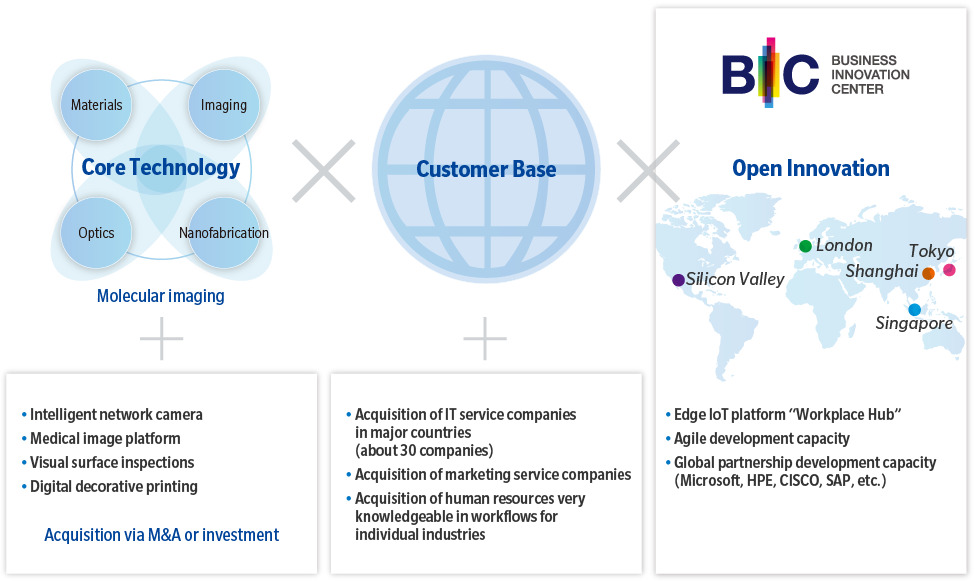
As in the preceding fiscal year, we maintained close relationships with our customers and tried to anticipate problems, providing solutions by adding services to products as part of our strategy to establish a high value-added sales model and implement it worldwide.
In our mainstay Business Technologies Business, our bizhub series of A3 color MFPs, core products in our genre-top strategy for the office service field, retained its momentum and saw unit sales increases in all business regions. Although competition remains fierce in the MFP market, we have succeeded in achieving penetration particularly in North America and Western Europe with our hybrid-type sales model—featuring document solutions centered on Konica Minolta MFPs packaged with a range of IT services—resulting in improved per-customer sales and earnings ratio.
In the production print field, sales were up in North America, China, and Asia for the bizhub PRESS C1100, our top-of-the-line color digital printing system. Turning to our textile printing business, orders in France and Turkey for our high-productivity Nassenger SP-1 contributed to increased sales in the industrial inkjet field. Looking at industrial printing, with full-fledged sales activities underway in all markets for the AccurioJet KM-1 digital inkjet printer and the new MGI digital decorative printers, we have laid the groundwork for the implementation of our sales strategy.
Performance in our healthcare business was strong, buoyed by significant growth in DR (digital radiography) products thanks in part to Viztek in the U.S., and business expansion supported by robust sales of solution-oriented products in the primary care market. Sales were strong for all digital products in Japan, and the AeroDR cassette-type digital X-ray diagnostic imaging system continued performing well in Japan and abroad. Sales volume for the SONIMAGE HS1 diagnostic ultrasound system increased dramatically in Japan, and sales of the system were launched in the U.S. and China.
Unfortunately, concerning our Industrial Business, materials and components were faced with increasingly challenging business conditions. Sales volume and revenue for performance materials decreased compared with the previous year due to increased price pressure. This came in spite of progress being made in the shift to high added-value products such as VA-TAC films for LCD TVs, Zero-TAC films for IPS panels, and ultra-thin TAC films for small- to medium-sized displays. Sales of optical systems for industrial use rose, due in part to the shipment of measuring instruments at the end of the fiscal year following the securing of a large order. Industrial and professional lens sales dropped, however, due to the effects of a decline in sales to end-product markets.
As a result, consolidated net sales for the period were ¥962.5 billion (down 6.7% year on year), operating profit of ¥50.1 billion (down 16.5%), and profit attributable to owners of the company of ¥31.5 billion (down 1.3%). As a whole, the Group recorded decreases in revenue and profit. However, these figures were greatly impacted by exchange-rate volatility. Although the yen started weakening in the fall, for the period it was much stronger than the corresponding period the previous fiscal year against both the U.S. dollar and the Euro. This contributed to a ¥91.8 billion decrease in sales and a ¥19.6 billion decline in operating profit. Looked at in real terms excluding the effect of the exchange rate, sales increased about 2% year on year while operating profit rose approximately 16%.
Despite continuing severe business conditions, we maintained annual dividends for the period at the previous year's level of ¥30 per share. Konica Minolta's basic stance on dividends places a greater emphasis on absolute value than the dividend payout ratio. The Company will continue investments toward realizing sustainable growth while improving business performance so that we can proactively distribute the profit and cash generated and meet our shareholders' expectations.
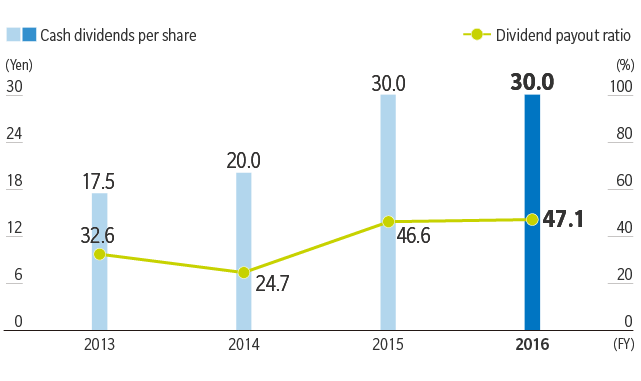
Toward ensuring that the preparatory steps taken under the previous Medium Term Business Plan generate tangible results, Konica Minolta launched its new Medium Term Business Plan, SHINKA 2019, in April 2017. "SHINKA” (evolution) reflects our strong commitment not only to transforming our business portfolio through the efforts made in the previous Medium Term Business Plan (TRANSFORM) but also to supporting innovation by our corporate clients, to generating new value that will support the "evolution" of the business ecosystems of those companies and society as a whole, and contributing to the resolution of issues that plague society.
Becoming a "digital company with insight into implicit challenges" is the corporate vision we have outlined in the new Medium Term Business Plan. Having insight into implicit challenges means working with our customers and society to identify not only problems that are already evident but also to anticipate potential problems, and collaborating in the development of solutions. Our aim is to take advantage of the digital technologies we have developed over the years as well as the AI, robotics, IoT, and other game-changing technologies now available to quickly identify the problems our customers face. We will then leverage these technologies—fortified through the preparatory steps taken to this point—along with our accumulated expertise, and take the lead in working to solve those problems.
These solutions and services businesses originate not from products, but from customers. Our efforts so far have been focused on our transformation into a company that provides customer-oriented products and services. The fact is, however, that our sales activities are still very much business oriented. It’s clear to me that it will take more time for us to achieve the ideals of One Konica Minolta.
SHINKA 2019 therefore takes an entirely different tack, focusing on re-examining our businesses from the perspective of the customer or the market. The launch of this new plan heralds the beginning of our efforts to fundamentally reform our sales system while transitioning from our traditional business and product-specific sales approach to a Go-To-Market (GTM) system oriented toward business type. This will involve looking at our customer base of two million companies around the world by industry and type of business, integrating the knowledge and expertise we have accumulated in the development of products and services, and going beyond our business and product framework to offer optimum solutions for each customer. We will then work in a unified manner to propose ways for our customers to optimize their workflow processes based on their area of business.
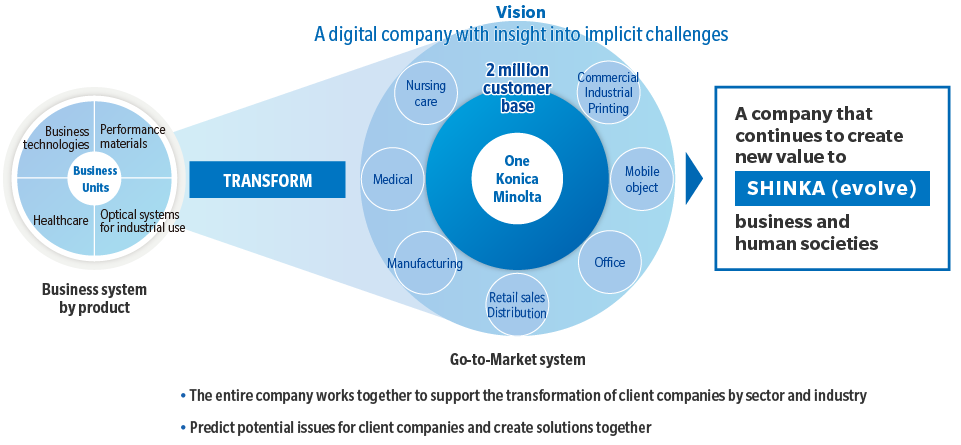
To achieve the transformation into a high-profit company under SHINKA 2019, we have realigned the Group’s business domains under three headings: core businesses, growth businesses, and new businesses. Going forward, we will clarify the profit responsibilities for each business as we transition to a new earnings structure.
Key issues for Konica Minolta management to address over the next three years (fiscal 2017 to 2019) will be improving the profitability of core businesses while bringing to fruition the objectives of the various preparatory steps taken under the previous Medium Term Business Plan in our growth and new businesses.
For our core businesses, which currently generate the lion's share of our earnings, management regards boosting profitability as a top priority. As the markets in which these businesses will operate are in advanced stages of maturity, we will improve profitability by focusing on reforming our cost structure on a global level rather than on expanding earnings by increasing the scale of operations.
We also plan to take action toward reducing costs by roughly ¥30 billion over the next three years. Concerning production costs, we are aiming to save about ¥16 billion through the horizontal deployment of digital manufacturing techniques used at our Malaysian plant to production facilities in China and elsewhere. We also expect to lower service costs by about \6 billion through initiatives that include leveraging deep learning, AI, and other technologies in predicting failures, strengthening remote services, and prolonging the life of parts. With regard to administration and indirect costs, our goal is to achieve a reduction of roughly ¥8 billion over three years by, among other means, greatly simplifying the Group's indirect functions.
Rather than treating core, growth, and new businesses as independent entities, we believe we need to approach this new structure as an integrated, three-pronged strategy. Our goal is to transform the entire Group into a high-profit "digital company with insight into implicit challenges." We intend to accomplish this by strengthening the relationships with customers that we have cultivated through the operation of our core businesses and leveraging the experience we have accumulated toward the expansion of growth businesses and the creation of new business models. The objectives of the new Medium Term Business Plan, are to achieve ¥75 billion or more in operating profit, ¥50 billion in net profit, and an ROE of 9.5% by fiscal 2019, the final year of the plan.
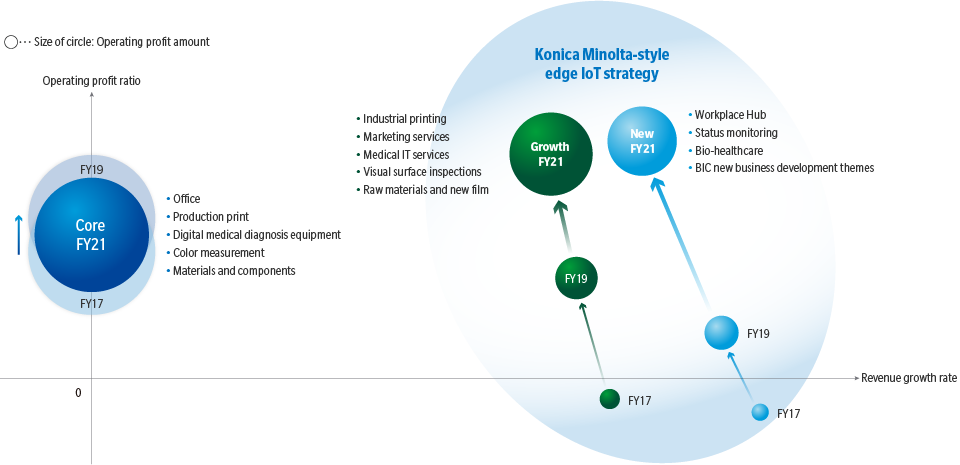

Something that I am promoting with great conviction with respect to our growth businesses and new businesses is our Edge IoT platform strategy and the partner strategy that will enable us to take advantage of it. Having a customer base of two million companies around the world means that Konica Minolta's networked MFPs, digital medical diagnostic devices, and measuring instruments are deployed at two million businesses. Having this vast platform through which we are connected to our customers in real time gives us a major advantage at the "edge," where data is input and digitized.
There is no shortage of IT companies providing cloud services including big data analysis and deep learning, and I have no intention of going head-to-head with them. Although Konica Minolta's platform-based business utilizes cloud services, the management and business issues faced by our customers are resolved in real time at their worksites (at the "edge") by collecting and analyzing data on the platforms deployed at those worksites. The "Edge IoT platform” (a platform for analyzing and resolving problems at the edge) itself is value we provide to the customer and is something that differentiates us from our competitors. With this platform now in place, we can pursue high profitability.
The Workplace Hub (WPH) announced in March 2017 serves as the core element of our Edge IoT platform strategy. The WPH supports increased workflow efficiency at workplaces in a broad range of industries extending beyond general office environments to encompass production facilities, medical care providers, and educational institutions. At the same time, it analyzes constantly changing real-time data, enabling the visualization of the status of IT infrastructure usage and of workers in action. These features allow us to provide solutions helpful in reducing customers’ IT infrastructure management costs and making their business processes more efficient.
In the process of putting this platform to use in solving industry- and business-specific problems as mentioned above, the preparatory steps that have been taken over the past three years will begin to bear fruit. For example, connecting a MOBOTIX camera to the WPH would enable a company to conduct real-time tracking of movement and activity inside offices and plants, making possible efficient circulation planning and use of space. Connecting measurement hardware from Radiant to the WPH would allow manufacturers, once defective products had been discovered, isolate the process where the problem originated, or which supplier’s quality test was insufficient. In the healthcare industry, connecting Viztek's IT platform for primary care to the WPH would enable comprehensive management of medical images, hospital management, and management of patient data.
The ecosystem in which we co-exist with our partners will be essential in executing this strategy. In commercializing the WPH, we formed a partnership system with Microsoft, Hewlett Packard Enterprise, CISCO Systems, and SAP. These large IT companies face cost constraints in marketing directly to our customers, the majority of which are small and medium-sized enterprises. We hope that by using our platform they will become able to provide services to enterprises previously out of their reach.
By unifying all of the benefits achieved through our M&A and product development activities, we aim to implement these strategies toward transforming Konica Minolta into a digital company with insight into implicit challenges, capable of providing our customers with comprehensive support in innovating their businesses.
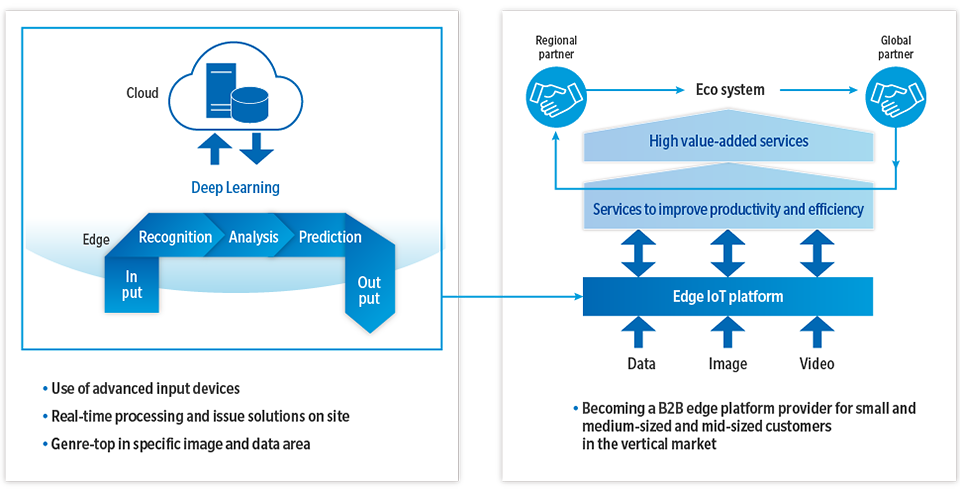
Konica Minolta positions bio-healthcare as a new business. Japan is struggling with rising healthcare costs resulting from its aging population, and two of the biggest issues are ineffective medications and those with strong side effects. As a possible solution to these issues, precision medicine is attracting attention globally. Precision medicine is a medical model that involves identifying the genetic expressions, proteins, and other characteristics of individual patients’ cells at the molecular level, precisely classifying individual patients, and then administering the proper medicine, treatment, or preventive measures based on the patient's characteristics. In addition to the potential improvements in effectiveness of medication and treatment provided to patients, precision medicine is seen worldwide as a possible solution to improving new drug development success rates at pharmaceutical companies and to ballooning healthcare costs.
This prompted Konica Minolta to launch precision medicine business operations last year with the development of High Sensitive Tissue Testing (HSTT), a technique that enables the digitizing of the number and location of proteins manifesting in cancer cells and high-sensitivity, molecular-level tissue analysis.
And in July of this year we announced our acquisition of Ambry Genetics ("AG"), a U.S.-based genetic testing business, in partnership with the Innovation Network Corporation of Japan (INCJ), marking our full-fledged entry into the field of precision medicine. As a company specializing in genetic testing services, AG is a leading presence in the U.S. market, home to state-of-the-art genetic diagnostic techniques. This acquisition makes Konica Minolta one of the only companies in the world to have two core technologies essential to precision medicine: genetic testing and cytoscreening using HSTT.
By tackling these serious societal issues head on, we seek to grow our healthcare operations into a high-profit business indispensable to society. Our initial targets are sales of ¥100 billion and operating profit of ¥20 billion by fiscal 2021. Beyond that, we will work to become a world-leading healthcare company in Asia and Europe, as well as in Japan and the U.S.
It is my belief that enhancing corporate value over the medium- to long-term requires strengthening every area of the company’s operation, and we will be working hard to improve competence even with regard to ESG and other non-financial indicators. This does not imply a passive approach that seeks to merely minimize ESG-related risks; the goal is to work proactively toward becoming a global top runner in ESG. To this end, last year we identified the "six material issues." Although all require our attention, I consider the "environment" and "social innovation" issues particularly important for our future business expansion.
Climate change and other environmental challenges are pressing issues for the international community. Konica Minolta has established a set of long-term environmental goals in the form of Eco Vision 2050, and has taken steps toward solving environmental problems while also achieving corporate growth. In fiscal 2017 we established an objective we named "carbon minus." This calls for working with stakeholders including business partners, customers, and members of the community to achieve the elimination of CO2 emissions reductions exceeding the volume of emissions by 2050. My aim is to contribute to reducing environmental impact to a degree much greater than we could achieve on our own.
We will also be focusing on “social innovation" efforts with the aim of developing businesses oriented toward resolving societal issues. There are numerous areas in which Konica Minolta can apply its capabilities in addressing key societal problems. These include improving nursing and primary care in an aging society, providing precision medicine to the bio-healthcare industry, working style reform is accomplished in offices, innovating manufacturing techniques at production sites, and developing new business models for the distribution and retail sectors.
Two other equally important material issues are "human capital" and "diversity." The final key to our becoming a digital company with insight into implicit challenges is achieving a "human capital transformation," and our hope is to develop worldwide a force of people to stand at the forefront of change and tap into their ample creative resources to create value for the customer. Moreover, through the Group-wide expansion of businesses that contribute to advancing society and resolving societal issues, we hope to maximize employee motivation and drive. I have taken the lead in promoting diversity. We will continue to work to create an environment which is conducive to employees fully realizing their potential and creativity, regardless of nationality, gender, or age, by changing the way work is accomplished, instituting career advancement programs, and executing reforms to the organizational structure and corporate climate.
Working on these material issues will serve to strengthen our global competitiveness and, as a signatory to the UN Global Compact, contribute to achieving the SDGs toward the creation of a sustainable society.
With respect to corporate governance, while we have endeavored to improve the effectiveness of our system, I want to raise the bar even further. This will entail focusing on "offensive governance" as a keyword while undertaking the cultivation of more strategic discussion by the Board of Directors, the implementation of a Director compensation system tied to the achievement of Medium Term Business Plan objectives are achieved, and other measures.
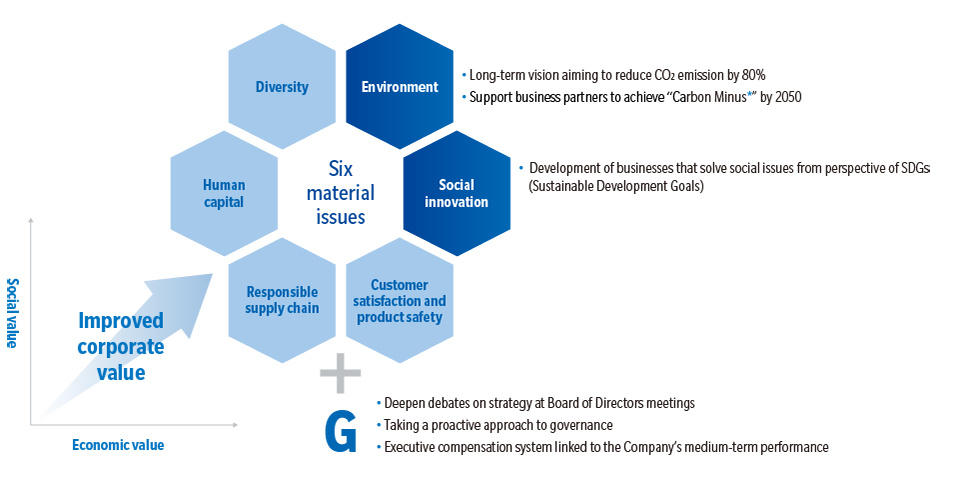
As I mentioned, I firmly believe that helping to solve problems our customers and their employees face by working to achieve the aims of SHINKA 2019, our new Medium Term Business Plan, can only benefit society.
Anticipating and isolating customers' problems and collaborating to devise solutions to support their transformation will make us an essential partner. Conducting these activities continuously and working tirelessly to contribute to the evolution of business and society—this is the kind of company Konica Minolta aspires to be. Once Konica Minolta has accomplished all it has set out to do in the Medium Term Business Plan, I believe we will have become a vital entity not only to our customers, but to society as a whole.

President and CEO
Konica Minolta, Inc.